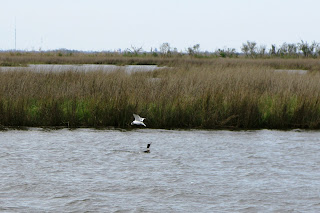Built in 1856 the plantation’s
original name was Sans Frusquin. Its French
slang and means “without a penny in my pocket.”
The name stems from the plantation owner’s lament about his German wife’s
spending to decorate the plantation. The
interior is more European then other homes in the area.
The ground floor includes the wine cellar,
china pantry, billiard room and dining room.
The dining room has a table that it 26 feet long and seats 24
people. The floor is finished with brick
that was ground to a fine dust and then applied like stucco. The final appearance
is crushed velvet.

The wine cellar also contains the
master’s shower. This is a really
interesting contraption. State of the art at the time, it took two people to
work it while the master bathed. One slave filled the lower tank with
water. Then a slave pumped the
water to an overhead cistern. The bather then pulled a chain to release the
water.
The main floor contains the homes
main entrance and reception area, the ladies drawing room, men’s drawing room,
master bedroom, children’s bedroom, boudoir, green sitting room, grey sitting
room and bedroom for the oldest son and a large porch facing the Mississippi.
The green sitting room includes a
table with a petticoat mirror under it. Ladies would use this mirror to check
to be sure their ankles or petticoat were not showing. In the day, an ankle was VERY titillating.
The boudoir was used as a birthing
room. Once the baby was delivered, mother and child remained in the room for
six weeks to ensure the baby was not exposed to anything. The ceiling in the boudoir has cherubs
painted on it. The skin color is quite dark and the faces are those of adults
not infants. The effect is very odd.
The grey sitting room includes a “fainting
couch.” I’ve heard the term many times
but never understood its use until the tour.
Fashion dictated that ladies have tiny waists. To achieve that, ladies
had their lower ribs removed. Then they
wore a corset. These corsets were laced
so tight that ladies would sometimes have trouble breathing. At San Francisco
Plantation ladies would retreat to the grey room where a maid would undo the
laces on the corset. This would allow
blood to rush to the lower extremities causing the lady to faint on the couch!
The ladies drawing room is painted a
brilliant light purple. The room is elaborately decorated with decorative painting on the walls, ceilings and fireplace mantle.
The room
contains a courting chair. This allowed the young couple to sit beside each
other, but facing in different directions. When a young man came courting the couple was always chaperoned. Mother sat in the room feigning knitting or
reading while ease dropping on the couple. The room also contains a mirror strategically
placed so that father could sit across the hall in the men’s sitting room and also
keep an eye on the couple. Courting candles were used to set boundaries for his
daughter. When the daughter's suitor came calling, the father would light the
courting the candle. When the candle burnt to the metal at the top of the candle
holder, it was time for the suitor to promptly leave. However, the father could
change the height of the candle based on how comfortable he felt about the suitor.
 The most interesting thing about the
main floor is that many of the rooms are formed by LARGE folding doors. When all the doors are open and the furniture
is removed the space can be used as a ballroom. Since the walls are not really
fixed and load bearing walls there are numerous cast iron Corinthian columns
that support the third floor, roof and widows walk.
The most interesting thing about the
main floor is that many of the rooms are formed by LARGE folding doors. When all the doors are open and the furniture
is removed the space can be used as a ballroom. Since the walls are not really
fixed and load bearing walls there are numerous cast iron Corinthian columns
that support the third floor, roof and widows walk.
The third floor is a REALLY HUGE
attic enclosed with shutters. Every day during warm weather servants would go
up in the attic and open all the shutters to allow a cool breeze from the river
to flow through the house.
The house was eventually abandoned
and remained empty for 40 years. In 1973 the plantation was purchased by a
local oil company who deeded a small plot of land and the house to the San
Francisco Plantation Foundation. After several years of research the oil
company underwrote $2,000,000 to restore the house to its former glory.











































